Bronze horse
Solid-cast by means of the direct lost wax technique, the horse’s anatomy was reduced to its essence and depicted with geometrical shapes, following principles of symmetry and balanced proportions. The animal is fixed on a rectangular plinth with three rosettes of triangles pierced straight through. Aesthetically, this rectangular base significantly influences the three-dimensional effect of the pieces. Such bases with openwork (perhaps used as stamps) appeared after the middle of the 8th century BCE and disappeared towards the end of the Geometric period.
Thousands of early bronze horses were found in most sanctuaries of ancient Greece, especially in Olympia. They served essentially as personal offerings to the gods. This example was probably made in Corinth.
Thousands of early bronze horses were found in most sanctuaries of ancient Greece, especially in Olympia. They served essentially as personal offerings to the gods. This example was probably made in Corinth.
Artwork Details
- Title: Bronze horse
- Period: Late Geometric
- Date: mid-8th century BCE
- Culture: Greek
- Medium: Bronze
- Dimensions: H. 3 5/16 in. (8.4 cm)
- Classification: Bronzes
- Credit Line: Gift of the H. L. Bache Foundation, 1969
- Object Number: 69.61.4
- Curatorial Department: Greek and Roman Art
More Artwork
Research Resources
The Met provides unparalleled resources for research and welcomes an international community of students and scholars. The Met's Open Access API is where creators and researchers can connect to the The Met collection. Open Access data and public domain images are available for unrestricted commercial and noncommercial use without permission or fee.
To request images under copyright and other restrictions, please use this Image Request form.
Feedback
We continue to research and examine historical and cultural context for objects in The Met collection. If you have comments or questions about this object record, please contact us using the form below. The Museum looks forward to receiving your comments.
